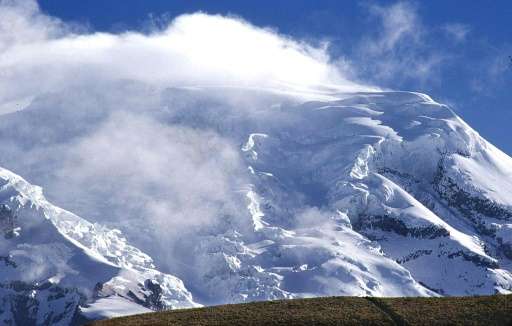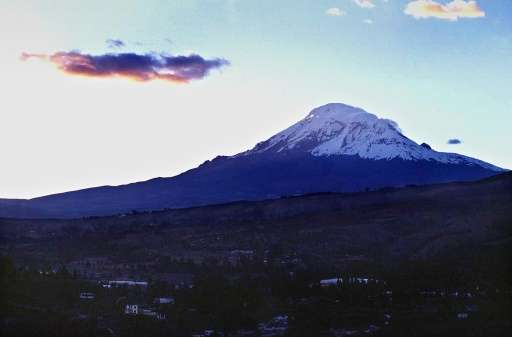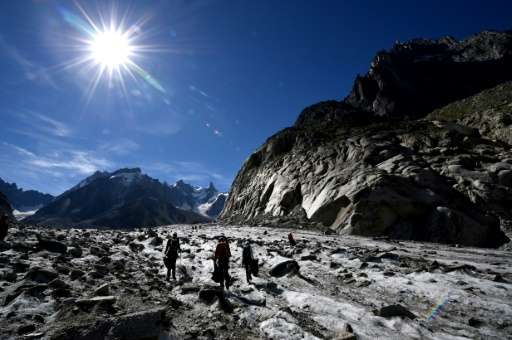Preserving the memory of glaciers

Locked up in about 140 metres (460 feet) of ice capping a Bolivian mountain lie 18,000 years of climate history, dating back to an epoch when humans were only just learning to farm.
But this precious archive of environmental change since the last Ice Age is melting fast, to the despair of scientists.
They have now decided to take matters in hand, in a remarkable initiative that combines glaciology with high-altitude trekking.
An international team will set out in May on a gruelling trip up Bolivia's 6,400-metre Illimani peak to drill three ice cores from its crowning glacier.
These will be preserved for posterity, along with cores from other glaciers, in the natural freezer that is Antarctica.
"Eventually, these ice cores will be all that is left of the glaciers," said Jerome Chappellaz of France's CNRS research institute, a partner in the endeavour dubbed Ice Memory.
Glacier ice contains traces of gas, chemicals and dust.
Analysed in the lab, this is a treasure trove of data on past changes in the climate and environment, including rainfall trends, forest fires, atmospheric temperatures, levels of greenhouse gases and chemical pollutants. They provide a crucial benchmark for understanding how our climate is mutating.
"The glaciers... hold the memory of former climates and help to predict future environmental changes," said the Institute of Research for Development (IRD), another mission member.
But time is running out.
"If global warming continues at its current rate, glaciers at an altitude below 3,500 metres in the Alps and 5,400 metres in the Andes will have disappeared by the end of the 21st century," said the IRD.
"These are unique pages in the history of our environment which will... be lost forever."

A glacier is a slow-moving mass of ice formed when snow accumulates year after year, compacting the layers below into a dense body of ice.
Sanctuary
At the Illimani site, two metres of snow fall every year, translating into a very detailed record that by now lies 140 metres deep.
"Studying the glacier therefore means the past of this environment can be reconstructed as far back as the Last Glacial Maximum (LGM)"—the peak freeze, about 21,000 years ago, during the last Ice Age, mission coordinators said in a statement.
At the time, vast ice sheets cover much of North America, northern Europe, and Asia, before starting to melt as the climate warmed, allowing modern humans to thrive and spread.
The Illimani expedition is the second leg of Ice Memory.
The first three ice cores—between 126 and 129 metres long—were taken from the Col du Dome glacier in Mont Blanc in the Alps in August last year.
They have been placed in a deep freeze at a research institute in Grenoble, at the foot of the Alps, to eventually be moved to the French-Italian Antarctic research base Concordia.
There a cave is being prepared for their permanent storage at an average of minus 54 degrees Celsius (minus 65.2 degrees Fahrenheit)—a temperature that should keep them safe even at top-of-the-scale global warming.
The "ice archive sanctuary" should be ready by 2020.
In the end, the team hopes to amass hundreds of ice samples.
But drilling an ice core at these kinds of altitudes is no easy feat.

"It requires a lot of equipment," Illimani project head Patrick Ginot of the IRD told AFP ahead of the team's departure.
"Twenty guides and carriers will help us to transport the material from an altitude of 4,500 metres to the summit at 6,300 metres.
There is a passable road for up to 4,500 metres, but beyond that not even a helicopter can go.
The helpers will carry the material, all 1.5 tonnes or 30 cubic metres of it, up the last 1,800 metres on their backs—about 30 kilogrammes per person at a time.
'Property of humanity'
The kit includes the core drill, 75 specially insulated boxes, and camping gear. It all left from Grenoble on a 10,000-kilometre (6,200-mile) boat ride for La Paz in February.
Upon reaching the summit, two teams of six to eight people will take turns drilling, so as to minimise the physical challenges of high-altitude exertion.
The mission will take about a month, after which the team will have an estimated three tonnes of ice to bring back down.
The precious samples will be placed in the 75 insulated boxes to travel to Grenoble on a five- to six-week boat journey.
"One of the most difficult challenges will be to maintain the cold chain," said Ginot.
One core from Col du Dome and one from Illimani, will remain in Grenoble for analysis, while the other four are bound for Antarctica.
"These samples will be the property of humanity," said the IRD.
They will be preserved "in order to enable future generations of scientists to carry out unprecedented analysis."
© 2017 AFP
















